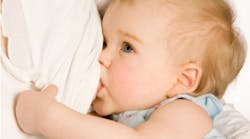There is no medical consensus on the link between human breast milk and early childhood caries, although many dental professionals strongly believe it causes decay. Considering the innumerable benefits of breastfeeding for the first year of an infant's life, dental hygienists should rethink how they approach this topic in order to offer the best possible support for the breastfeeding relationship.
Is human breast milk (HBM) cariogenic? According to the late Brian Palmer, DDS, an anthropologist or mammologist would answer, “no.” (1) Why? Out of the more than 4,000 species of mammals, the only species' milk accused of causing decay in the teeth of its young is human milk. (1) It doesn't make sense for a species’ specific milk to be cariogenic to its young. Humans have been breastfeeding long before early childhood caries (ECC) reared its ugly head. Early human infant skulls validate this theory. Dr. Palmer spent many of his years studying these skulls and found little to no decay. (1)
What do the professions of pediatric medicine and dentistry say? The official position of the American Academy of Pediatrics (AAP) is, that yes, human milk is cariogenic. (2) In an effort not to mislead the reader, this article may not provide a satisfactory answer to the question of cariogenicity of human milk. In fact, many readers may have already made their minds up, having witnessed ECC in infants and toddlers who exclusively breastfeed. The intent of this article is to not only highlight the weak evidence linking HBM to caries, but more importantly, inspire our profession to create strategies that support breastfeeding moms all the while fighting ECC.
Let's begin by reviewing how the AAP arrived at the "official position" that human milk is indeed cariogenic.
The AAP based its position primarily on a 2005 rat study. This study used desalivated rats to mimic the scenario thought to be found when infants nurse ad libitum, or on demand, day and night. The animals received basic nutrition, and the fluids tested were available on demand. The conclusion: "Human milk was significantly more cariogenic than cow milk probably because of its lower mineral content and higher level of lactose." (2)
Here's the thing about rat teeth—they're rat teeth. A little tidbit found on the website of Anders P. Hakansson’s lab states, "desalivated rats are much more sensitive to caries induction by lactose than regular rats." (3, 9) This study may prove HBM is cariogenic to rats with no saliva drinking through an artificial nipple, but in no way does this in vitro model mimic a human mother breastfeeding their baby. Human milk studies should have human test subjects and human teeth at least and such studies do exist.
ALSO BY CHRISTIE LINCOLN |Overcoming the challenges of pumping breast milk as a dental hygienist
The human studies
Numerous articles accusing breastfeeding as a cause of decay have been population-based studies. According to a 1999 article in JADA, "population-based studies do not support a definitive link between prolonged breast-feeding and caries.” (4) Why? Many of the studies had contradictory findings and weak methodology. (5, 6) Various other studies fail to "employ the internationally adopted definitions of breastfeeding. Some authors do not present a definition for ECC [early childhood caries], while others use multiple definitions or their own definitions." (7) Valaitis et al. in a systematic review of 151 articles concluded that there is no strong and consistent evidence between breastfeeding and the development of ECC. (7, 8)
A study authored by Pamela R. Erikson, DDS, PhD, and Elham Mazhari evaluated "caries-free children in good general and oral health, with no dental anomalies, between the ages of 12 and 24 months and who were still breastfeeding." (10) The conclusions were that:
- "HBM does not cause a significant pH drop in plaque;
- HBM supports moderate bacterial growth;
- Calcium and phosphorus are actually deposited onto enamel powder after incubation with HBM;
- The buffer capacity of HBM is very poor; [and]
- HBM is not cariogenic in an in vitro model, unless another carbohydrate source is available for bacterial fermentation." (10)
What about all the sugar in HBM?
HBM contains the milk sugar lactose. Lactose is naturally designed to be digested and broken down in the lower intestine, not in the mouth. Lactose alone can be broken down in a lab, but this does not take into account that while in breastmilk, it is surrounded by protective components. (1) One in particular is lactoferrin, which "in breast milk can kill Streptococcus mutans." (12) Also, antimicrobial components (lactoferrin, ogliosaccharides, and others), are present in higher concentrations in HBM. (11, 12)
Science validates the complexity of HBM and the need for further research. (13) The American Academy of Pediatric Dentistry reports that "epidemiological research shows that human milk and breast-feeding of infants provide general health, nutritional, developmental, psychological, social, economic, and environmental advantages while significantly decreasing risk for a large number of acute and chronic diseases. Human breast milk is uniquely superior in providing the best possible nutrition to infants and has not been epidemiologically associated with caries. Frequent night time bottle feeding with milk and ad libitum breast-feeding are associated with, but not consistently implicated in ECC." (14)
OK. Now what?
No matter how the evidence is presented and validated, the fact remains breastfed babies are susceptible to caries. We've seen it with our own eyes. The more important question is, how can the profession of dental hygiene help in the fight against ECC, but also support its breastfeeding patients? The health benefits of breastfeeding the first 12 months are too vast to elaborate on in this article.
Allow me to confess: telling a nursing mom to stop breastfeeding during the night when baby's first teeth appear or to brush a half-asleep baby's teeth after a middle-of-the-night nursing session —well, let's just say from personal experience, neither suggestions have strong compliance. Are we seeing the benefits of instructing mothers to stop or change their breastfeeding routine?
Instead, what if we have different conversations? In alternative settings? Before teeth erupt? About transmission? About the airway and mouthbreathing? About hidden sources of sucrose? Right now, most RDHs are found in dental offices, whether public or private, where children present with ECC as an existing condition. Could RDHs have a bigger impact by working with pediatricians, government agencies or programs where parents are counseled well before their baby's teeth erupt?
The future of dental hygiene is bright and full of possibilities. We need only to think outside of old values and parameters to see the potential.
Editor's note: Christie Lincoln is the cohost of the MOMgienists podcast. Listen here.
For the most current dental headlines, click here.
Editor's note: This article first appeared in RDH eVillage. Click here to subscribe.
References
1. Palmer B. Infant Dental Decay - Is it related to Breastfeeding? http://www.brianpalmerdds.com/caries.htm. Accessed April 27, 2017.
2. Bowen WH, Lawrence RA. Comparison of the cariogenicity of cola, honey, cow milk, human milk, and sucrose. Pediatrics. 2005;116(4):921-6.
3. Anders Hakansson Laboratory home page. http://hakanssonlab.com/. Accessed April 27, 2017.
4. Slavkin HC. Streptococcus mutans, early childhood caries and new opportunities. J Am Dent Assoc. 1999;130(12):1787-1792.
5. Sinton J, Valaitis R, Passarelli C, Sheehan D, Hesch R. A systematic overview of the relationship between infant feeding caries and breast-feeding. Ont Dent. 1998;75(9):23-27.
6. Pagila L. Does breastfeeding increase risk of early childhood caries? Eur J Paediat Dent. 2015;16(3):173.
7. Ribeiro NM, Ribeiro MA. Breastfeeding and early childhood caries: a critical review.J Pediat(Rio J). 2004;80(5 Suppl):S199-210.
8. Valaitis R, Hesch R, Passarelli C, Sheehan D, Sinton J. A systematic review of the relationship between breastfeeding and early childhood caries. Can J Public Health. 2000;91(6):411-7.
9. Hakansson A. Breast-feeding, human milk, and caries. https://www.acsu.buffalo.edu/~andersh/research/milkcaries.asp. Accessed April 27, 2017.
10. Erickson PR, Mazhari E. Investigation of the role of human breast milk in caries development. Pediatric Dent. 1999;21(2):86-90.
11. Shetty V, Hegde AM, Nandan S, Shetty S. Caries protective agents in human milk and bovine milk: an in vitro study. J Clin Pediatr Dent. 2011;35(4):389-92.
12. Lönnerdal B. Bioactive proteins in breast milk. J Paediatr Child Health. 2013;49 Suppl 1:1-7. doi: 10.1111/jpc.12104.
13. Unique biology of human breast milk. Science Daily. https://www.sciencedaily.com/releases/2016/04/160419130002.htm. Published April 19, 2016. Accessed April 27, 2017.
14. Guideline on Infant Oral Health Care. American Academy of Pediatric Dentistry website. http://www.aapd.org/media/policies_guidelines/g_infantoralhealthcare.pdf. Accessed April 27, 2017.
Christie Lincoln, RDH, is a practicing clinical hygienist, mother of three, and cohost of the MOMgienists podcast. She also uses her website yoursmilinghygienist.com to inspire the public to seek and engage the fullest potential of a dental hygienist, in an effort to uplift and highlight the integral role of this unique, often underestimated, health-care provider. Christie is also enjoys volunteering and is actively seeking certification in the arena of lactation consulting.






